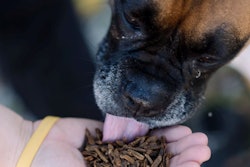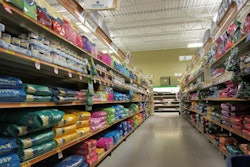
Euromonitor International released a new edition of pet care industry data. This new edition of research provides the latest insights on the dog and cat food industry performance in 2018 and key prospects through 2023.
Pet food industry concentration and competition
Pet food is a fairly concentrated industry with the top five companies accounting for 41 percent of global sales, wrote Paula Flores, Euromonitor International’s head of pet care research. While this is impressive and indeed quite different to other CPG industries, the fact remains that global manufacturers have been under significant pressure. While Blue Buffalo has represented a success story for many years, its 138 percent growth in the past five years indicates how pet owners are willing to spend on their pets’ nutrition. More recently Rachel Ray has achieved astonishing success, being one of the fastest growing brands in 2017. The common denominator being that both these companies have been the targets of recent M&A – already in 2018.
The US is not the only market to see increased competition though, with a similar trend seen in developed markets to a different extent. In Asia, local players have also stepped up their credentials, using their knowledge of local consumers and leveraging local synergies as competition intensifies.
Cat ownership gains momentum
Recent developments in the industry have seen the rise of cats’ popularity in many markets, largely overtaking dogs’ popularity. Felines have captured the limelight due to their playful and typically more independent nature, making them the perfect companions for fast paced, urbanised young owners. This is also reflected not only in sales of cat treats but also in terms of cat food. In fact, the category has been experiencing high levels of premiumisation with more nutrient rich, alternative protein and functional diets hitting the shelves. Global premium cat food sales are expected to expand by 4 percent in 2018 with absolute growth sales expected to reach US$2 billion between 2018 and 2023. While premium pet food has caught much of the attention not all consumers are this affluent and mid-price cat food is also expected to post good growth.
Online retail maintains strong growth trajectory
While store-based retail accounts for the majority of pet care retail sales, online retail has been gaining significant traction across developed and a number of developing markets, wrote Flores. This is particularly the case in the US where growth rates have exploded. This is on the back of PetSmart’s acquisition of Chewy (a pure play retailer) as well as Target and Walmart’s omni-channel push and Amazon stepping up its game in pet care.
Price, convenience, and product selection remain among the key motivators behind the consumer shift towards e-commerce. This is even more relevant when looking at Asia, where consumers are mobile-savvy and social media plays an increasing role. Platforms such as Tmall and Lazada are growing their presence and offering an increasing number of products.
No end to premiumization?
Premiumization helped define and generate growth in the industry for many years, but the different ways it has done so have changed over time. New, locally and sustainably sourced ingredients are playing a key role in adapting to consumers’ most demanding needs. The rise in healthy living lifestyles has impacted the way owners interact with their pets, especially the way they feed them. Globally, premium dog and cat food has experienced strong growth with 25 percent value growth over the last five years and an expected 4 percent CAGR for the period up to 2023, according to Euromonitor International’s latest estimates.















